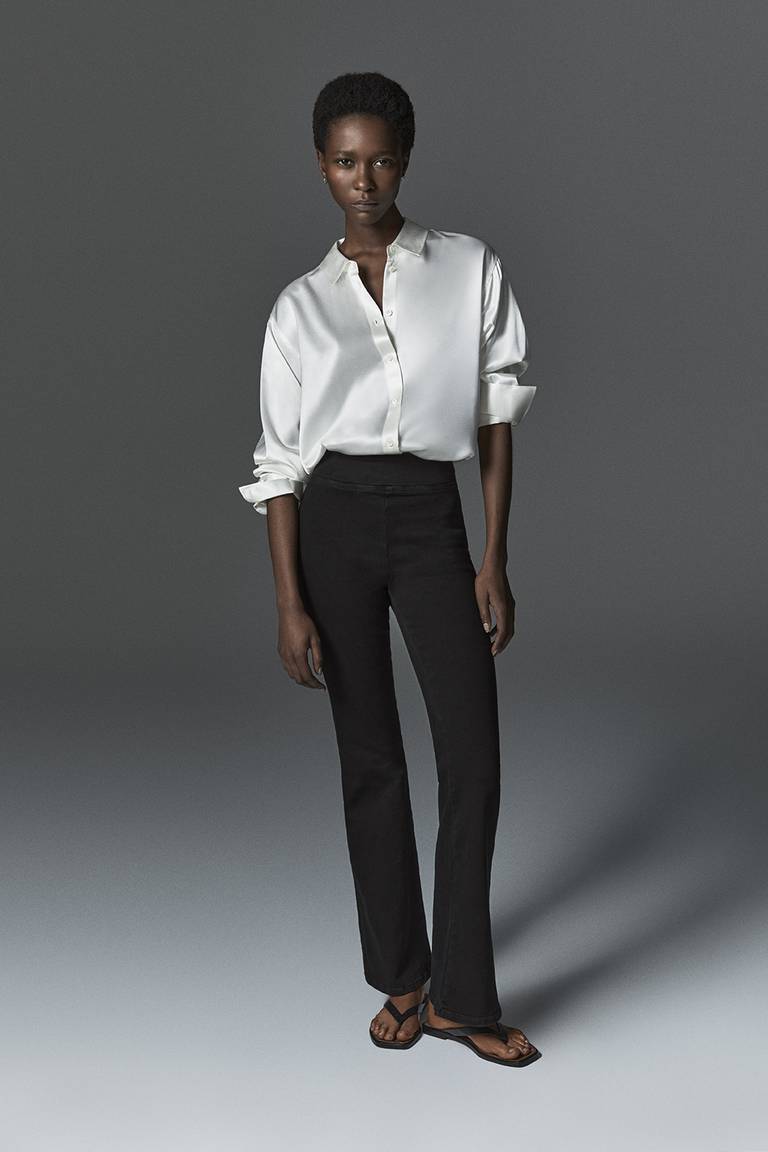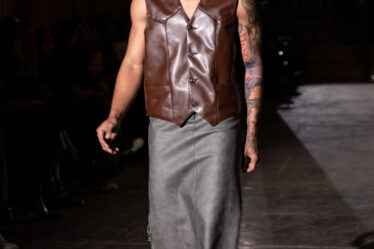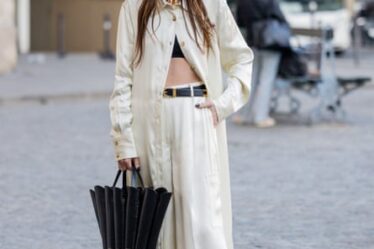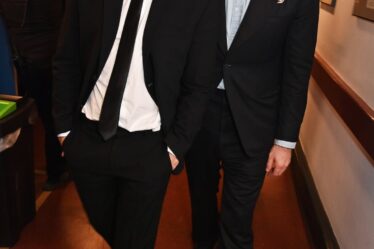
A year ago, denim brand Frame launched its stretchiest pair of jeans yet — soft, flared pants that fit like leggings but look as sharp as trousers, designed to be the perfect travel bottoms. The “Jetset” pants became Frame’s best-selling style in 2022, and now include six different silhouettes.
“It’s our reaction to leggings,” said Erik Torstensson, co-founder of Frame. “Other people make leggings, and they do it well, but it’s our job to make you look amazing but comfortable.”
The Jetset may be Frame’s answer to leggings, but in many ways, it flips the concept of athleisure on its head. Since the mid-2010s, when the term “athleisure” first started gaining traction, it was all about wearing made-for-comfort pieces in a fashionable way, exuding an aspirational sense of effortlessness. Think Kendall Jenner in a crop top and black leggings, or J.Lo in head-to-toe sweats.
Today, many consumers are ditching their pandemic-era leggings. But they are still prioritising the feeling of comfort that a well-worn pair of sweatpants exudes, whether they’re shopping for jeans and trousers or dresses and even formal attire. Dress pants with hidden elastic waists, zipperless dresses are made from knit fabrics and suits in loose silhouettes are now the norm at weddings, in boardrooms and beyond.
In other words, athleisure isn’t dead; it’s so ubiquitous you don’t notice it anymore.
“What it means to be modern right now in fashion is to be comfortable,” said Rachel Tashjian, fashion news director at Harper’s Bazaar. “It’s not just, ‘Wow, everything is becoming more athleisure-oriented or more casual,’ but that we’ve taken the lesson from athleisure, that people really want to be comfortable, and designers have made things that are comfortable but also spiffy and sharp.”
That’s small comfort to the brands that made a killing on leggings and sweatpants in the late 2010s, and especially during the pandemic. Some, such as Entireworld and the US arm of Australian activewear brand Lorna Jane, folded. Others are pivoting; Outdoor Voices has found immense success with its exercise dress, which others have imitated since its release in 2019. Athleta, meanwhile, has highlighted more fashion-forward pieces in its recent collections over core activewear staples. Its new arrivals for spring include a wide-leg jumpsuit designed for “commuting, work, and travel,” and bright orange parachute pants — a staple in the current Y2K revival in fashion.
Meanwhile, Lululemon saw sales spike 30 percent in its most recently reported quarter, with growth driven by its signature yoga pants but also new categories like hiking and tennis.
The incorporation of comfort and performance technology into everyday wear — a mutation of athleisure — doesn’t quite have a name yet. Before it carried the womenswear brand Leset, known for casual-but-stylish matching sets of boxy tops and stretchy pants, Neiman Marcus created a brand new category called “Luxe Essentials.” Brands that didn’t have an obvious way into the athleisure trend now see a huge opportunity.
Recently, “there’s been a recalibration of categories,” according to Arielle Siboni, fashion director, ready-to-wear, at Bloomingdale’s. Dresses are no longer selling as quickly, she said, and in its place, customers are “looking for ways to look presentable but feel comfortable” with pieces like cargo pants, cargo jeans, wide-leg trousers and trench coats.
Though still popular, the loafer and ballet flat resurgence of last year is waning, Siboni added, as shoppers are looking to pair their comfy pants with sneakers.
“At one point, everyone looked like they rolled out of bed, and no one seemed to care,” said Torstensson. “But people today are tired of seeing leggings everywhere.”
In other words, athleisure is no longer a fashion statement in and of itself, but has faded into every corner of apparel. And like any trend, the athleisure look has lost its aspirational edge after years of mainstream saturation.
“For a while, it was a part of this wealthy elite [aesthetic] and then it hit mass and began to fade into the background,” said Diana Tsui, a stylist and freelance fashion journalist.
Dressing Up, Dressing Down
When Lili Chemla created Leset, at the tail end of 2019, she was confident she had found a white space in the market: clothes for women who were getting tired of wearing their leggings everywhere.
“People were prioritising their comfort over style, and it started to look a little slouchy,” Chemla said. “I always felt underdressed … It felt lazy.”
Her solution? Oversized button downs, drawstring pants, knit tops and bottoms in solid colours, sold as separates but can be easily styled as sets. The idea is that these pieces are cosy enough for work-from-home days on the couch but chic enough to wear to the club. Leset’s motto? “Night in. Night out. You are all set.”
Chemla may have been slightly ahead of her time. Leset’s business saw a slight dip when gowns and cocktail attire were having a moment in 2021, but sales doubled last year.
Like Frame’s Jetset franchise, Leset exemplifies the evolution of athleisure from traditional “lazy” staples to proper fashion pieces that are just as soft and pliable, but stylish too. They also demonstrate customers’ need for another modern attribute: versatility.
“Everyone is trying to cater to this woman who is constantly on the move,” said Chemla. “It’s a new class of universal clothing.”
Even Lululemon, the patron saint of aspirational athleisure, has long embraced the melding of technology-driven comfort and fashion that’s formal enough in which to attend a work meeting or wear on a date. Its ABC pants for men, made from a proprietary stretchy fabric one would typically see on a pair of running shorts, have been named a cult-favourite again and again since it was released in 2014.
“The ABC pants launched a revolution of what you can do with wear-to-work attire,” said Simeon Siegel, managing director and senior analyst at BMO Capital Markets, pointing to other brands that have released similar products, such as Rhone’s stretchy, moisture-wicking Commuter shirt.
“If athleisure injected fashion into athletic pieces, increasingly, we’re seeing almost every brand inject athletic [qualities] or technology into fashion,” he added.
The Legging Phenomenon
Leggings, meanwhile, are retreating back to their pre-athleisure place in the market, as something to wear to the gym, not the office.
The legging sell-out rate in early 2023 is 24 percent lower than last year and remains below 2020 levels, according to retail intelligence firm Edited. Among the assortment of leggings in the market, consumers by far prefer styles tagged as performance-wear, which are selling out faster than “lifestyle” leggings by 470 percent, Edited data shows.
“I think at this point leggings are [confined] to the activewear realm, but I am excited to see elevated leggings pop up especially as customers return to the office,” said Siboni.
Leggings have certainly not disappeared from the front lines of fashion. Leset’s most popular pant style over the last four years is its signature stir-up pant: black leggings in a stretchy ponte fabric that can be styled with heels or with sneakers.
And last month, in a series of particularly nostalgic looks, Miu Miu sent models down the runway in plain black and grey leggings paired with sneakers and zip-up hoodies — a familiar outfit among city-dwelling professional women in the mid-and late-2010s.
“I think a lot of people are just confused with fashion right now,” said Tashjian. “It used to be that there were particular looks that dominated, but right now there’s something exciting happening: There are a ton of options, and there’s not one right thing or cool thing to wear.”



